
Eriospermum is a genus of tuberous flowering plants. It contains about 80-100 species, native to sub-Saharan Africa.
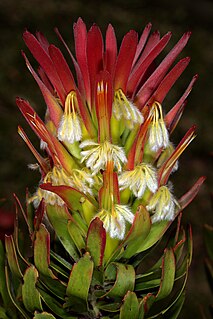
Mimetes, the pagoda, is a genus of evergreen shrubs or small trees 0.5–6 m (1.6–19.7 ft) high, with thirteen species assigned to the family Proteaceae. This genus, as with other proteas, is popular with nectarivorous birds such as the Cape sugarbird and several sunbird species. All species of Mimetes are endemic to the Cape Floristic Region of South Africa.

Leucospermum cordifolium is an upright, evergreen shrub of up to 1½ m (5 ft) high from the Proteaceae. The flower heads are globe-shape with a flattened top, 10–12 cm (3.9–4.7 in) in diameter, and are carried individually or with two or three together mostly at a right angle to its branch. The perianth is 3–3½ cm long, yellow, orange or crimson in color. From each flower emerges a 4½–6 cm (1.8–2.4 in) long style sticking out horizontally but curving upwards near the obliquely, shell-shaped, thicker pollen presenter. This gives each head the appearance of a pincushion. Its common name is ornamental pincushion in English and bobbejaanklou in Afrikaans. It flowers between the middle of July and the end of November. It naturally occurs near the south coast of the Western Cape province of South Africa. Varieties and hybrids of this species are used as cut flower and garden plant.
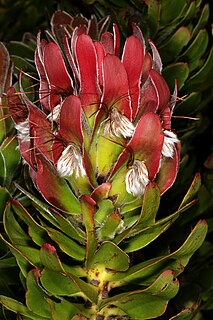
Mimetes fimbriifolius, also called cowl pagoda or the fringed pagoda, is a species of plant in the family Proteaceae. It is a dense, rounded, multi-branched tree that grows up to 4 metres in height. This attractive and striking plant flowers all year round, and produces red and yellow branch-heads and inflorescences. The nectar-rich flowers are pollinated by sunbirds and the seeds are distributed and taken underground by ants before germinating. It is endemic to the Table Mountain range in the city of Cape Town, South Africa.

Leucospermum hypophyllocarpodendron is a creeping, mat-forming shrub with heads of yellow flowers and leathery, upright narrow leaves with some red-tipped teeth at their tips, from the family Proteaceae. It has long thin branches that originate from an underground rootstock and grows on poor, sandy soils in southwestern South Africa. The rose-scented flower heads can be found for August to January and are visited by different monkey beetles, bees and flies. It has two subspecies, one with greyish leaves U-shaped in cross section called grey snakestem pincushion in English and gruisslangbossie in Afrikaans, the other with green leaves that are flat in cross-section called green snakestem pincushion and groenslangbossie.
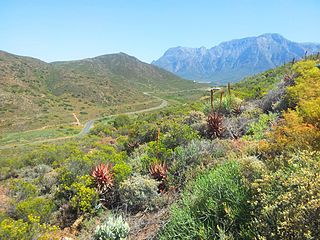
Robertson Karoo is a semi-arid vegetation type, restricted to sections of the Breede River Valley, Western Cape Province, South Africa. It is a subtype of Succulent Karoo and is characterised by the dominance of succulent plant species, and by several endemic plants and animals.

Leucospermum cuneiforme is an upright evergreen shrub with many pustules growing on the lower branches, wedge-shaped leaves, and oval, initially yellow flower heads that later turn orange, with long styles sticking far beyond the perianths, jointly giving the impression of a pincushion. It is called wart-stemmed pincushion in English and luisiesbos (lice-bush) in Afrikaans. The species is common in the southern mountains of South Africa.
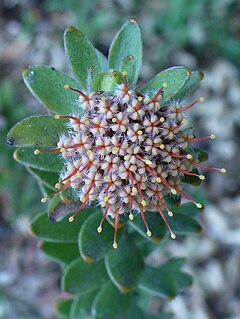
Leucospermum truncatulum is a slender, upright, evergreen, hardly branching shrub of up to 2 m (6 ft) high, with felty inverted egg-shaped to oval, leaves with entire margins of 1–2½ cm (0.4–1.0 in) long and ½–1 cm (0.2–0.4 in) wide. It has small globe-shaped, at first yellow, later pinkish flower heads of 1½–2 cm (0.6-0.8 in) in diameter, without a stalk, usually crowded with two to eight together near the end of the stems. It is known as oval-leaf pincushion in English, and patrysbos or kleinkopspeldekussing in Afrikaans. It is an endemic species of the south of the Western Cape province of South Africa, and flowers between August and December.

Glottiphyllum depressum is a common species of succulent plant, of the family Aizoaceae, native to South Africa.
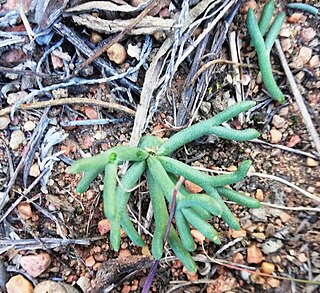
Eriospermum bowieanum is a species of geophytic plant of the genus Eriospermum, endemic to the Robertson Karoo region of the Western Cape Province, South Africa.
Eriospermum cooperi is a species of flowering plant of the Asparagaceae family. It is a summer rainfall species found in rocky grassland and open scrub from the Eastern Cape, South Africa to Zimbabwe. It has a solitary erect leaf, white to pale green flowers and grows to 60 cm. The outer tepals are sometimes reddish brown.
Eriospermum breviscapum is a species of geophytic plant of the genus Eriospermum, indigenous to South Africa.
Eriospermum dregei is a species of geophytic plant of the genus Eriospermum.
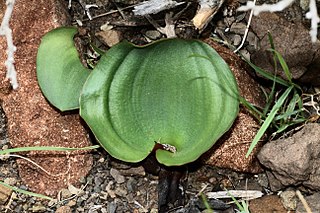
Eriospermum capense is a species of geophytic plant of the genus Eriospermum, indigenous to the Western Cape Province, South Africa.
Eriospermum bayeri is a species of geophytic plant of the genus Eriospermum, indigenous to the Western Cape Province, South Africa.
Eriospermum proliferum is a species of flowering plant in the Asparagaceae family.
Eriospermum graminifolium is a species of geophytic plant of the genus Eriospermum, indigenous to South Africa.
Eriospermum pubescens is a species of geophytic plant of the genus Eriospermum, indigenous to the southern Cape, South Africa.
Eriospermum lanceifolium is a species of geophytic plant of the genus Eriospermum.
Eriospermum exile is a species of geophytic plant of the genus Eriospermum, indigenous to South Africa.










